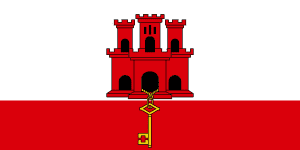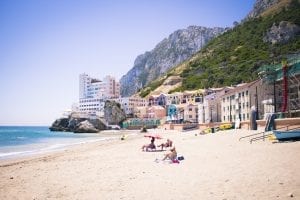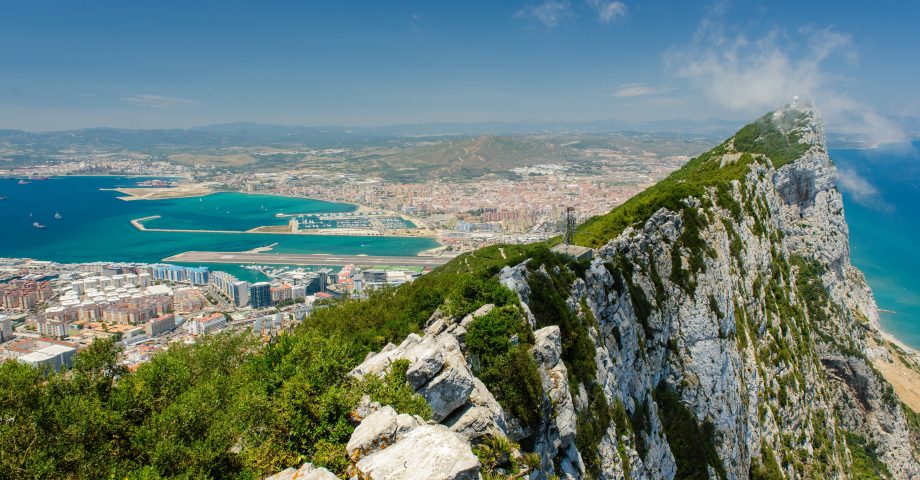1. Where is Gibraltar?
A limestone outcrop, Gibraltar is located on the southern end of the Iberian Peninsula, at the entrance of the Mediterranean.
2. Gibraltar is very small indeed.
It has an area of just 2.6 square miles (6.8 square kilometres). In 2022, Gibraltar had a population of 32,649.
3. It’s technically British territory.
It’s a British overseas territory and shares its northern border with the Province of Cádiz in Andalusia, Spain; Gibraltarians are British citizens.

4. Its name carries a lot of history.
Gibraltar is named in Arabic Jabal Tariq, after the Muslim commander Tariq Ibn-Ziyad. He turned ‘the rock’ into a fortress in 711 A.D, and it has been an important naval base for more than 1,000 years.
5. It’s a multi-lingual, multi-cultural territory.
Most Gibraltarians are bilingual in English and Spanish, and are of mixed Genoese, British, Spanish, Jewish, Maltese and Portuguese descent.
6. Gibraltar’s income is interesting to say the least.
The majority of Gibraltar’s income comes from customs duties, offshore finance, internet gaming, tourism and the provisioning of ships because it doesn’t have a large agricultural or industrial trade.
7. There’s a species of monkey here that’s unique to Europe!
Barbary Macaques, a species of tailless monkeys, in Gibraltar are the only free-living monkeys in Europe today; there are approximately 230 that have made Gibraltar their home.
8. Ancient ruins give way to fascinating history here.
The Tower of Homage is all that remains of the Moorish Castle that dates back to the 11th Century. The castle saw a lot of action, especially during the 16th Century (1540) when hundreds of people found safety inside the castle when Turkish pirates attacked Gibraltar.
A British flag has flown at The Tower of Homage ever since Admiral Rooke erected the first British flag here when he captured the Rock in 1704.
9. What are the Great Siege Tunnels?
Gibraltar is home a labyrinth of tunnels known as The Great Siege Tunnels. They are said to be the most impressive defense system devised by man, created when France and Spain made an attempt to recapture the Rock from the British in Gibraltar’s 14th siege; the siege lasted from July 1779 right through until February 1783.

10. What is St Michael’s Cave?
Earlier, in 1704, 500 Spanish soldiers were discovered in Gibraltar’s St Michael’s Cave, preparing an attack to recapture Gibraltar from the British.
St Michael’s Cave was thought to be bottomless and people believed that the Rock of Gibraltar was linked to the Continent of Africa by a subterranean passage over 15 miles (24km) long under the Strait of Gibraltar. Imagine that…
11. It was very nearly an emergency point.
Although never utilised, St Michael’s Cave was prepared as an emergency hospital during WW2.
12. Do the caves lead to other countries?
This cave is linked to a second cave in Gibraltar known as Leonora’s Cave and it was rumored that they both link Gibraltar to Morocco.

13. You’ll never be bored here.
There’s a lot to see and do in Gibraltar from sightseeing and exploring the rock’s history to diving, fishing, shopping, excursions and birdwatching.
14. Want to call Gibraltar? No problem.
Want to call your friends or family in Gibraltar? You’ll need to use the international dialling code +350.
FAQs about Gibraltar
What is the national flower of Gibraltar?
The national flower of Gibraltar is the candytuft. It withstands the salty sea air of the coast, and can be easily seen growing across the rock!
What are the people of Gibraltar known as?
The people of Gibraltar are known as Gibraltarians. The majority of Gibraltarians are British and have British passports.
Is Gibraltar a ‘free’ country?
Yes - the United Nations, in fact, sees it as its own state separate from the UK in terms of governance, being a ‘Non-Self-Governing Territory’.
Do you know any fun facts about Gibraltar? Share them in the comments below!
Are you fascinated with learning more about British overseas territories? Check out these interesting facts about the Falkland Islands









